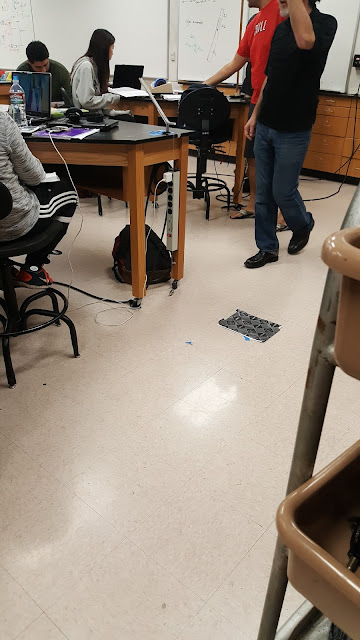Purpose: To determine the moment of inertia of a triangle on a spinning base by using a hanging mass with known value, without having to calculate all of the individual moments of the separate pieces on the spinning base. Then compare with value for moment of inertia as calculated by using the parallel axis theorem.
Apparatus: The setup that we used for this lab is the same as the one that we used for lab 16, except the only difference is that above the pulley there was a mount for attaching a metal triangle with a hole through its center of mass.
Procedure: The procedure was simple, let the setup accelerate three times, and then record the up α and the down α, then take an average of the two. The three setups were as follows:
1) The system was allowed to accelerate without the triangle on the mount/hinge.
2) The metal triangle was mounted on the hinge, with the short base parallel to the ground, then the system was allowed to accelerate.
3) The triangle was rotated 90 degrees so that the long base would now be parallel to the ground.
The specs for the triangle are:
Mass = 454.7g
Short base = 98.1 mm
Long base = 149.1mm
The hanging mass was 24.9g, and attached to a torque pulley of radius 0.01245m
The values for the angular acceleration were recorded through logger pro as always. The angular acceleration for the system without the triangle was needed in order to calculate the moment of inertia for the system, then subtract it from the moment of the system with the triangle on it. This would then yield the moment of inertia of just the triangle.
Raw data:
My calculations for the moment of inertia around center of mass.
My calculations for the moments of inertia by experiment.
Theoretical moments of inertia.
Percent Error:
At first the percent error for the short base and long base configuration was 48.7% and 50.0% respectively. This lead me to believe that I may have used the incorrect sized pulley for my calculations due to it being off by a factor of 2. After I made an adjustment by multiplying the experimental values by 2, the error changed to 2.65% for the short base and 0.065% for the long base.
Conclusion: Assuming that all my calculations are correct, I think that this lab went well. However, I do regret taking so long to write up this lab because as with all the other experiments, after writing up the lab I have a much more solid understanding of the concepts we are studying. Not only do I have solid understanding of how moment of inertia is just a value for the mass distribution about a radius, but now I understand the parallel axis theorem better. However, I do not understand how the theoretical value for the triangle with the longer base is larger than the experimental value. This makes no sense because the theoretical value is assuming that the system does not have friction in it.
My lab partners were Mia and Jarrod.


















































